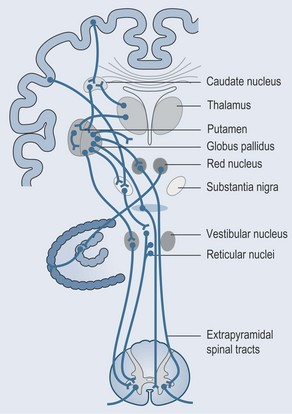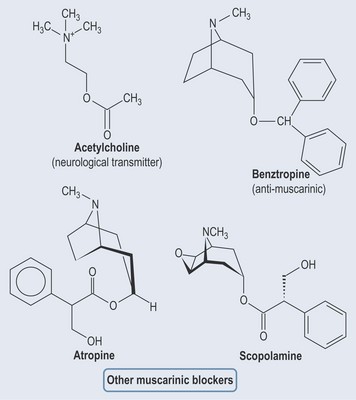Chapter 33 Neurological disease
Epilepsy
The different epileptic syndromes are divided into two main types:
The highest rates of epilepsy are in children and elderly people.
The neurotransmitters involved in epilepsy are largely amines. Drugs associated with neurological disease tend to be a type of amine, which is why plant alkaloids can have a similar effect (see Chapter 23 ‘Amines and alkaloids’, p. 175).
General Discussion of Medication
The aim is to treat the patient without causing side effects and using a single drug. Sodium valproate is usually the drug of choice. Carbamazepine (Tegretol or Carbatrol; see Figure 33.5) and phenytoin (Dilantin or Phenytek) can be used in its place, but are considered alternatives.
Carbamazepine is the drug of choice for partial seizures. It is a tricyclic antidepressant derivative and is thought to work by blocking the calcium and sodium channels on the neurons (see Chapter 31 ‘The nervous system’, p. 237). Because of this, it has been used in neuralgias and certain types of dystonia. Because it induces its own metabolism (it is an enzyme inducer) its half-life can fall dramatically during chronic administration. It is therefore started at a low dose, which is gradually increased.
Ethosuximide is used instead of sodium valproate for absence (petit mal) seizures.
Phenobarbital is now only used when other treatments fail; it is an inexpensive medication.
Pharmacokinetics of Anticonvulsants
Anticonvulsants tend to have interactions with a wide range of drugs, but particularly those that bind to the plasma proteins (see Chapter 16 ‘How do drugs get into cells?’, p. 126) or those metabolized by the liver (see Chapter 17 ‘Metabolism’, p. 129).
A third of patients will need more than one drug to keep the condition under control.
Parkinson’s Disease
Aetiology
The basal ganglia, the red nucleus, the substantia nigra, the reticular formation and the cerebellum are all part of the extrapyramidal system, which controls gross autonomic motor movement (Figure 33.1). The basal ganglia inhibit the rapid firing of the motor neurons. This control is reduced when the inhibitory function of dopamine is lessened; hence the increase in tremors through lack of inhibition.
Treatment
Dopamine cannot cross the blood–brain barrier and therefore cannot be used as therapy. However, its precursor, levodopa, can cross the barrier and enter the brain. Once in the brain, it is converted to dopamine (Figure 33.2), thereby increasing the levels and helping to reduce symptoms. Dopamine agonists are used largely in an effort to maintain the dopamine levels in the body.
Antimuscarinic Drugs
These are used in patients in whom Parkinson’s has been induced by antipsychotic drugs or recreational drugs. They reduce the effects of the cholinergic excess in the CNS, which occurs as a result of dopamine deficiency (Figure 33.3).
< div class='tao-gold-member'>
Stay updated, free articles. Join our Telegram channel

Full access? Get Clinical Tree





